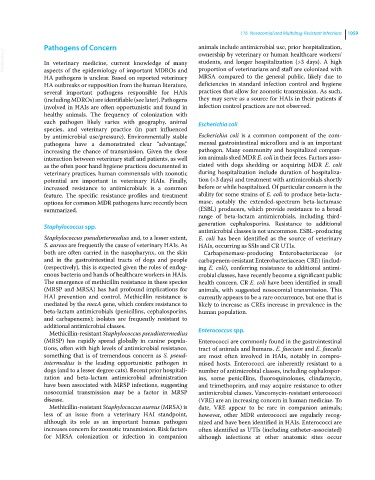Page 1121 - Clinical Small Animal Internal Medicine
P. 1121
116 Nosocomial and Multidrug‐Resistant Infections 1059
Pathogens of Concern animals include antimicrobial use, prior hospitalization,
VetBooks.ir In veterinary medicine, current knowledge of many ownership by veterinary or human healthcare workers/
students, and longer hospitalization (>3 days). A high
proportion of veterinarians and staff are colonized with
aspects of the epidemiology of important MDROs and
HA pathogens is unclear. Based on reported veterinary MRSA compared to the general public, likely due to
HA outbreaks or supposition from the human literature, deficiencies in standard infection control and hygiene
several important pathogens responsible for HAIs practices that allow for zoonotic transmission. As such,
(including MDROs) are identifiable (see later). Pathogens they may serve as a source for HAIs in their patients if
involved in HAIs are often opportunistic and found in infection control practices are not observed.
healthy animals. The frequency of colonization with
each pathogen likely varies with geography, animal Escherichia coli
species, and veterinary practice (in part influenced
by antimicrobial use/pressure). Environmentally stable Escherichia coli is a common component of the com-
pathogens have a demonstrated clear “advantage,” mensal gastrointestinal microflora and is an important
increasing the chance of transmission. Given the close pathogen. Many community and hospitalized compan-
interaction between veterinary staff and patients, as well ion animals shed MDR E. coli in their feces. Factors asso-
as the often poor hand hygiene practices documented in ciated with dogs shedding or acquiring MDR E. coli
veterinary practices, human commensals with zoonotic during hospitalization include duration of hospitaliza-
potential are important in veterinary HAIs. Finally, tion (>3 days) and treatment with antimicrobials shortly
increased resistance to antimicrobials is a common before or while hospitalized. Of particular concern is the
feature. The specific resistance profiles and treatment ability for some strains of E. coli to produce beta‐lacta-
options for common MDR pathogens have recently been mase, notably the extended‐spectrum beta‐lactamase
summarized. (ESBL) producers, which provide resistance to a broad
range of beta‐lactam antimicrobials, including third‐
Staphylococcus spp. generation cephalosporins. Resistance to additional
antimicrobial classes is not uncommon. ESBL‐producing
Staphylococcus pseudintermedius and, to a lesser extent, E. coli has been identified as the source of veterinary
S. aureus are frequently the cause of veterinary HAIs. As HAIs, occurring as SSIs and CR UTIs.
both are often carried in the nasopharynx, on the skin Carbapenemase‐producing Enterobacteriaceae (or
and in the gastrointestinal tracts of dogs and people carbapenem‐resistant Enterobacteriaceae; CRE) (includ-
(respectively), this is expected given the roles of endog- ing E. coli), conferring resistance to additional antimi-
enous bacteria and hands of healthcare workers in HAIs. crobial classes, have recently become a significant public
The emergence of methicillin resistance in these species health concern. CR E. coli have been identified in small
(MRSP and MRSA) has had profound implications for animals, with suggested nosocomial transmission. This
HAI prevention and control. Methicillin resistance is currently appears to be a rare occurrence, but one that is
mediated by the mecA gene, which confers resistance to likely to increase as CREs increase in prevalence in the
beta‐lactam antimicrobials (penicillins, cephalosporins, human population.
and carbapenems); isolates are frequently resistant to
additional antimicrobial classes.
Methicillin‐resistant Staphylococcus pseudintermedius Enterococcus spp.
(MRSP) has rapidly spread globally in canine popula- Enterococci are commonly found in the gastrointestinal
tions, often with high levels of antimicrobial resistance, tract of animals and humans. E. faecium and E. faecalis
something that is of tremendous concern as S. pseud- are most often involved in HAIs, notably in compro-
intermedius is the leading opportunistic pathogen in mised hosts. Enterococci are inherently resistant to a
dogs (and to a lesser degree cats). Recent prior hospitali- number of antimicrobial classes, including cephalospor-
zation and beta‐lactam antimicrobial administration ins, some penicillins, fluoroquinolones, clindamycin,
have been associated with MRSP infections, suggesting and trimethoprim, and may acquire resistance to other
nosocomial transmission may be a factor in MRSP antimicrobial classes. Vancomycin‐resistant enterococci
disease. (VRE) are an increasing concern in human medicine. To
Methicillin‐resistant Staphylococcus aureus (MRSA) is date, VRE appear to be rare in companion animals;
less of an issue from a veterinary HAI standpoint, however, other MDR enterococci are regularly recog-
although its role as an important human pathogen nized and have been identified in HAIs. Enterococci are
increases concern for zoonotic transmission. Risk factors often identified as UTIs (including catheter‐associated)
for MRSA colonization or infection in companion although infections at other anatomic sites occur

